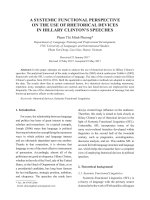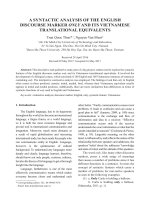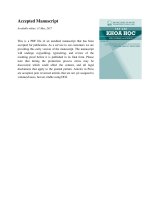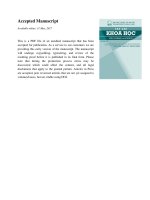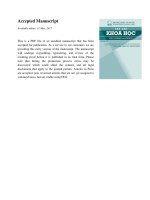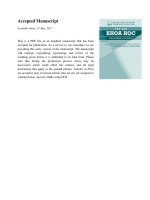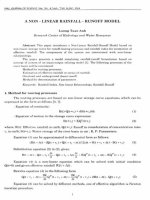DSpace at VNU: A parameterized unit test framework based on symbolic Java PathFinder
Bạn đang xem bản rút gọn của tài liệu. Xem và tải ngay bản đầy đủ của tài liệu tại đây (267.41 KB, 5 trang )
2009 International Conference on Knowledge and Systems Engineering
A Fast Template-based Approach to Automatically Identify Primary Text Content
of a Web Page
Dat Quoc Nguyen, Dai Quoc Nguyen, Son Bao Pham, The Duy Bui
Human Machine Interaction Laboratory,
College of Technology, Vietnam National University, Hanoi
web pages from the same website. The main disadvantage of
this algorithm is that it is quite slow when the number of
input web pages is large. Moreover, because
ContentExtractor algorithm does not preserve the
hierarchical order of output blocks, the extracted content
blocks may not appear in the same order as the original ones.
This might prevent the search engine from searching
correctly an exact phrase when the phrase spans across two
consecutive blocks.
In this paper, we propose FastContentExtractor - a fast
algorithm to automatically detect content blocks in web
pages by improving ContentExtractor. Instead of storing all
input web pages of a website, we automatically create a
template to store information of content blocks and possible
wrongly detected blocks for later retrieval. Each block in a
web page can be identified, although not always uniquely, by
a traversal path in a hierarchical tree of blocks which
represents the web page. A template contains a set of
absolute paths of content blocks and non-content blocks
having the same paths as that of content blocks. By storing
the absolute paths, the hierarchical order of the output blocks
is maintained which guarantees that the extracted content
blocks are in the same order as the original ones. After the
template for a website is stored, each newly crawled web
page is compared with the template to find its primary
content blocks. The number of extracted blocks and
comparisons in FastContentExtractor is much smaller than
that in ContentExtractor, which makes FastContentExtractor
faster than ContentExtractor.
The rest of the paper is organized as follows. We
summarize related materials and methods in Section II. In
Section III, we described our approach. Some experiments
are presented in Section IV in order to show the performance
of our approach.
Abstract—Search engines have become an indispensable tool
for browsing information on the Internet. The user, however, is
often annoyed by redundant results from irrelevant web pages.
One reason is because search engines also look at noninformative blocks of web pages such as advertisement,
navigation links, etc. In this paper, we propose a fast algorithm
called FastContentExtractor to automatically detect main
content blocks in a web page by improving the
ContentExtractor algorithm. By automatically identifying and
storing templates representing the structure of content blocks
in a website, content blocks of a new web page from the
website can be extracted quickly. The hierarchical order of the
output blocks is also maintained which guarantees that the
extracted content blocks are in the same order as the original
ones.
Keywords: data mining, template detection, web mining.
I.
INTRODUCTION
Nowadays, search engines have become an indispensable
tool for browsing information on the Internet. While there
are many useful search engines available, the users are still
annoyed by redundant results from irrelevant web pages.
One of the reasons is because web pages often contain noninformative blocks such as advertisements, links, etc. A
search engine, which lacks effective content block detection
capacity, often searches in non-informative blocks and
therefore produces redundant results.
A block in a web page is often defined as a part of web
page surrounded by an open tag such as <TABLE>, <TR>,
<HR>, <UL>, <P>, <SPAN>, <DIV> and a matching close
tag [11]. Detecting which blocks are primary text content
blocks not only induces huge efficiency in storage for a
search engine but also improves search efficiency in order to
increase users’ satisfaction. Manually marking content
blocks is not a feasible solution for a search engine. In this
paper, we consider the task of automatically detecting
content blocks in a web page.
Web pages on the same website usually have similar
structures. Furthermore, non-content blocks often situate in
fixed positions. Utilizing those observations, content blocks
in a web page can be automatically detected. At present,
several methods have been proposed to tackle this problem
including Content Extractor by Debnath et al. [11][12], noise
elimination method by Yi et al. [9], InfoDiscoverer by Lin
and Ho [13]. Among them, ContentExtractor appears to be
the most effective algorithm to extract primary content
blocks. For a web page, ContentExtractor finds content
blocks by comparing each of its blocks with all blocks of
978-0-7695-3846-4/09 $26.00 © 2009 IEEE
DOI 10.1109/KSE.2009.39
II.
RELATED WORKS
Several methods have been proposed to detect content
blocks or non-content blocks in web pages automatically. Yi
et al. [9] have proposed a tree structure which is called Site
Style Tree (SST) for each website based on observations.
SST is formed from the DOM tree of different web pages
from the same website. Yi et al. also presented formulas for
calculating the importance of each node in SST, which helps
to eliminate noisy information and gives primary content.
The problem of this approach appears when the number of
input web pages is large. Storing million sites in the World
Wide Web with SST then becomes a big issue. Kolcz and
Yih [2] presented a method to identify template blocks or
noisy blocks such as advertisement and navigation bars. By
232
visually separating web pages into blocks based on vertical
and horizontal lines, they calculated the block frequency for
each block. If the block frequency value of a block is high, it
is a template block, which is then labeled for building
template model. Mehta and Madaan [10] presented an
approach using regex-based template. By segmenting web
pages based on the template, they could detect important
sections. Vieira et al. [8] used tree mapping together with the
RTDM-TD Algorithm and the Retrieve Template Algorithm
for detecting the template. Lin and Ho [13] introduced a
method to identify content blocks by partitioning a web page
into blocks based on the <TABLE> tag. Entropy values of
the terms appearing in each block are calculated and used for
determining content blocks.
ContentExtractor [11][12] appears to be the most
effective algorithm to identify primary informative content
blocks. The input of this algorithm is a set of web pages that
are assumed to have similar structure. First, the algorithm
partitions each page into atomic blocks. An atomic block is a
block that does not contain any block. In the next step, with
an atomic block B, the algorithm calculates the number of
web pages that contain a block similar to B. If block B
occurs many times over different web pages, block B is
considered as a non-content block, and it is removed.
Otherwise, block B is considered a primary content block.
Figure 1 shows a block with corresponding <P> tag of a
web page. This block contains four atomic sub-blocks with
corresponding <span> tag (see the source code in Figure 2).
ContentExtractor then partitions the block into five blocks
(see Figure 3) which are the four sub-blocks and the original
block with sub-blocks removed.
To identify two similar blocks, ContentExtractor uses a
function to measure the similarity between two blocks. The
result of this function is the cosine between two feature
vectors that represent the two corresponding blocks. The
feature vector of a block may include the number of images,
the number of java scripts, hyperlinks and terms that appear
in the block. If the returned value of the measure function is
greater than 0.9, two blocks is considered similar. To
calculate the number of web pages which contain any blocks
similar to B, ContentExtractor algorithm compares B with all
blocks in all input web pages.
One main disadvantage of ContentExtractor is its low
speed when the number of input web pages is high. The
second disadvantage is that ContentExtractor does not
preserve the order of extracted content blocks. It is because
the process of partitioning each webpage into atomic blocks
changes the order of these blocks. Figure 3 shows the
extracted blocks from the paragraph in Figure 1, which are
not in the original order. This prevents an exact phrase
search to be carried out properly. For example, the phrase
“the US House of Representatives” will not be found in the
extracted text.
On Sept. 27, the US
id="lw_1223369478_0">House of
Representatives</span> unanimously passed
a resolution recognizing
id="lw_1223369478_1">The Christian
Science Monitor</span> on its centennial.
The measure was sponsored by
id="lw_1223369478_2">Rep. Lamar
Smith</span> (R) of Texas who once served
on the Monitor staff. It was cosponsored
by 40 other id="lw_1223369478_3">members of
Congress</span>.
Figure 2. The source code of the block in Figure 1.
id="lw_1223369478_0">House of
Representatives</span>
id="lw_1223369478_1">The Christian
Science Monitor</span>
id="lw_1223369478_2">Rep. Lamar
Smith</span>
id="lw_1223369478_3">members of
Congress</span>
On Sept. 27, the US unanimously
passed a resolution recognizing on its
centennial. The measure was sponsored by
(R) of Texas who once served on the
Monitor staff. It was cosponsored by 40
other .
Figure 3.
Extracted sub-blocks from the paragraph in Figure 1.
III.
OUR APPROACH
In this section, we describe our FastContentExtractor
algorithm that extends ContentExtractor algorithm. By
building and storing a template for each website, we can later
extract the primary content of any web page from that
website.
Different
from
ContentExtractor,
our
FastContentExtractor contains two phases: the preparation
phase and the detection phase. At the preparation phase,
FastContentExtractor collects a set of web pages from a
given website to automatically generate a template to
describe content blocks (see Figure 4). This phase is carried
out infrequently. Similar to ContentExtractor algorithm, first,
we identify content blocks from atomic blocks of the web
pages. We then store the traversal path of these blocks along
the hierarchical trees of blocks representing the web pages.
The traversal path of a block is a string of the form
“tag1.tag2.tag3….tagn” where the block with corresponding
Figure 1. A block with
tag.
233
tagi+1 is a sub-block of the block with corresponding tagi,
tagn is the tag of an atomic block, and tag1 is the most
generic
tag
“HTML”.
For
example,
“HTML.BODY.TABLE.TR.P” is the string representing the
traversal path to a block. The advantage of this way to
describe a block is the independence of its position in the
web page. The disadvantage of this way is that it does not
provide a unique way to identify a block in a web page.
Thus, two different blocks may have the same traversal path.
For this reason, we also store in the template the content of
non-content blocks which have the path as content blocks in
order to correctly identify content blocks in a new web page
later.
<span> tag are considered as content blocked and are
extracted.
Figure 5. The detection phase of the FastContentExtractor algorithm.
It can be seen that the number of comparisons in
FastContentExtractor is much smaller than that in
ContentExtractor. Moreover, while ContenExtractor
algorithm does not keep primitive structure of blocks in its
output, by using the paths of content blocks,
FastContentExtractor retains primitive structure of blocks to
keep information content intact.
IV.
RESULTS
We compare the execution time and accuracy between
our FastContentExtractor algorithm (FastCE) and our own
implementation of ContentExtractor algorithm (CE). Both
FastCE and CE take a set of web pages from the same site as
input and output the corresponding text content or primary
content blocks. In this experiment, we use both Vietnamese
and English websites as shown in Table I.
TABLE I.
Figure 4. The preparation phase of the FastContentExtractor algorithm.
THE WEBSITES USED IN THE EXPERIMENT AND THEIR
CORRESPONDING NUMBER OF WEB PAGES
Address
In the detection phase, by using the stored template of the
corresponding website, content blocks of a new web page
can be detected quickly (see Figure 5). Only blocks of the
new web page having the same paths as the paths stored in
the template are extracted. Denoting P as the set of paths
storing in the template and B is a block with a path in P, the
extraction rules are as follows:
if the path of all sub-blocks (if any) of B are in P, then
the whole block B is extracted;
if B contains a block B’ with a path not in P, then
if the path of all sub-blocks (if any) of B’ are not in
P, then block B is extracted without B’;
otherwise block B is extracted including B’.
An extracted block is not necessarily an atomic block.
Each extracted block is then compared with non-content
blocks stored in the template. If the block is considered
similar to a non-content block, it is considered as noncontent block. Otherwise, it is considered as content block
and its text is extracted as the primary text content of the web
page. For example, in Figure 2, all of blocks with
corresponding
tag and sub-blocks with corresponding
dantri.com.vn
kenh14.vn
thanhnien.com.vn
vietnamnet.vn
news.yahoo.com
cnn.com
news.bbc.co.uk
nytimes.com
Number of
web pages
337
269
290
365
115
191
106
100
We use between 20 to 30 web pages at the preparation
phase to generate the template for each website.
A. Execution time
In order to compare the execution time between FastCE
and CE, we define the following terms:
• NumBlockTemp refers to the number of blocks that are
used to compare to decide whether a block is a content
block.
• NumBlock refers to the averaged number of blocks that
are generated by each approach for each webpage in
input data set. NumBlock is the number of atomic blocks
234
for CE, and is the number of blocks that are generated
by using the paths of content blocks for FastCE.
• PerTime refers to the averaged execution time for each
web page from the input data set. PerTime includes the
time taken to extract blocks and to compare the
extracted blocks with the blocks stored in the template.
Because the number of blocks in the template and the
number of extracted blocks in FastCE approach is smaller
compared to that in CE, the comparison time between blocks
is smaller for FastCE approach. Similarly, the amount of
time taken to extract blocks in FastCE approach is smaller
than that in CE. Therefore, the overall execution time in
FastCE approach is smaller compared to CE approach as
illustrated in Table II and Figure 6. In fact the runtime for
FastCE is significantly better compared to that of CE across
all websites experimented.
TABLE II.
Address
dantri.com.vn
kenh14.vn
thanhnien.com.vn
vietnamnet.vn
news.yahoo.com
cnn.com
news.bbc.co.uk
nytimes.com
B. Accuracy
1) Block level accuracy. Similar to Debnath et al. [11],
we use BFmeasure as a metric to compare the accuracy:
BFmeasure =
NBT / NB /
PerTime
in FastCE
14 / 41 /
0.964
26 / 46 /
1.39
19 / 14 /
0.703
3 / 22 /
0.527
34 / 48 /
0.938
20 / 15 /
2.002
16 / 45 /
0.565
58 / 17 /
1.557
Brecall + B precision
Brecall is defined as the ratio between the number of
content blocks extracted and the actual number of content
blocks while Bprecision is defined as the ratio between the
number of content blocks extracted and the total number of
extracted blocks.
TABLE III.
EXECUTION TIME OF CE AND FASTCE
NBT / NB /
PerTime
in CE
86 / 319 /
1.914
247 / 500 /
18.4
111 / 326 /
1.817
23 / 121 /
0.563
114 / 171 /
1.883
112 / 266 /
2.924
77 / 174 /
1.401
318 / 146 /
2.273
2 * Brecall * B precision
BFMEASURE FOR CE AND FASTCE ON A NUMBER OF WEBSITES
Address
Improvement
on execution
time
dantri.com.vn
kenh14.vn
thanhnien.com.vn
vietnamnet.vn
news.yahoo.com
cnn.com
news.bbc.co.uk
nytimes.com
198.55%
1323.7%
258.5%
106.8%
BFmeasure
in CE
0.97
1.00
0.90
0.83
0.86
0.91
0.88
0.90
BFmeasure
in FastCE
0.97
1.00
0.89
1.00
0.92
0.75
0.94
0.91
Table III shows the measure of block level accuracy for
CE and FastCE on a number of websites. As can be seen
from the table, the accuracy of FastCE is similar to that of
CE.
2) Word level accuracy. In this section, we execute the
comparison based on word levels. We use WFmeasure as a
metric to compare the accuracy between FastCE and the CE:
200.7%
146.5%
247.9%
146%
WFmeasure =
2 *Wrecall *W precision
Wrecall + W precision
Wrecall is defined as the ratio between the number of
words in extracted primary content and number of words in
original primary content. Wprecision is defined as the ratio
between the number of words in extracted primary content
and total number of extracted words.
TABLE IV.
WFMEASURE FOR CE AND FASTCE ON A NUMBER OF WEBSITES
Address
dantri.com.vn
kenh14.vn
thanhnien.com.vn
vietnamnet.vn
news.yahoo.com
cnn.com
news.bbc.co.uk
nytimes.com
Figure 6. Average Processing Time for CE and FastCE.
235
WFmeasure
in CE
0.978
1.00
0.978
0.99
0.89
0.99
0.957
0.966
WFmeasure
in FastCE
0.991
1.00
0.992
0.999
0.958
0.99
0.96
0.966
It can be seen from Table IV that FastCE performs as
accurately as CE for most of the websites experimented.
V.
[5]
[6]
CONCLUSION
We proposed in this paper FastContentExtractor - a fast
approach for extracting primary content of web pages.
FastContentExtractor extends ContentExtractor algorithm by
building templates for each website at hand where the
template contains paths to the content blocks as well as
distinct non-content blocks. Experiments on both Vietnamese
and English websites have demonstrated the advantage of
FastContentExtractor over ContentExtractor. In particular,
FastContentExtractor outperformed ContentExtractor by a
high margin in runtime while maintaining the accuracy. In
addition, FastContentExtractor keeps text information content
intact which allows the exact phrase search to perform
correctly.
[7]
[8]
[9]
[10]
[11]
ACKNOWLEDGEMENT
[12]
This work is partly supported by the research project No.
QC.08.17 granted by Vietnam National University, Hanoi.
[13]
REFERENCES
[14]
[1]
[2]
[3]
[4]
A. Arasu, H. Garcia-Molina and S. University, “Extracting Structured
Data from Web Pages”, In Proceedings of SIGMOD, pages 337-348,
2003.
A. Kolcz and W. Yih, “Site-Independent Template-Block Detection”,
In Proceedings of PKDD, pages 152-163, 2007.
D. Cai, S. Yu, J.-R. Wen and W.-Y. Ma, “Vips: A Vision-based Page
Segmentation Algorithm”, In MSR-TR-2003-79, Microsoft, 2003.
D. Gibson, K. Punera and A. Tomkins, “The Volume and Evolution
of Web Page Templates”, In Special In- terest Tracks and Posters,
14th Int. Conf. on WWW, pages 830–839, 2005.
[15]
[16]
236
H. Song, H. Liu, J.-R. Wen and W.-Y. Ma, “Learning Block
Importance Models for Web Pages”, In Proceedings of 13th WWW,
pages 203-211, 2004.
J. Y. Hsu and W. Yih, “Template-based Information Mining from
HTML Documents”, In Proceedings of AAAI-97, AAAI Press, pages
256-262, 1997.
K. Lerman, L. Getoor, S. Minton and C. Knoblock, “Using the
Structure of Web Sites for Automatic Segmentation of Tables”, In
Proceedings of SIGMOD, pages119-130, 2004.
K. Vieira, A. Silva, N. Pinto, E. Moura, J. Cavalcanti and J. Freire,
“A Fast and Robust Method for Web Page Template Detection and
Removal”, In Proceedings of 15th CIKM, pages 256–267, 2006.
L. Yi, B. Liu and X. Li, “Eliminating Noisy Information in Web
Pages for Data Mining”, In Proceedings of 9th KDD, pages 296–305,
2003.
R. Mehta and A. Madaan, “Web page sectioning using regex-based
template”, In Proceedings of 17th WWW, pages 1151-1152, 2008.
S. Debnath, P. Mitra, N. Pal and C. L. Giles, “Automatic
Identification of Informative Sections of Web-pages”, In TKDE,
pages 1233–1246, 2005.
S. Debnath, P. Mitra and C. L. Giles, “Automatic extraction of
informative blocks from web pages”, In Proceedings of SAC, pages
1722-1726, 2005.
S.H. Lin and J.-M. Ho, “Discovering Informative Content Blocks
from Web Documents”, In Proceedings of KDD, pages 588– 59,
ACM, 2002.
X. Xiao and Q. Luo, “A Comparative Study on Classifying the
Functions of Web Page Blocks”, In Proceedings of CIKM, pages 776777, 2006.
Y. Wang, B. Fang, X. Cheng, L. Guo and H. Xu, “Incremental Web
Page Template Detection”, In Proceedings of 17th WWW, pages
1247-1248, 2008.
Z. Bar-Yossef and S. Rajagopalan, “Template Detection via Data
Mining and its Applications”, In Proceedings of 11th WWW, pages
580-591, 2002.


